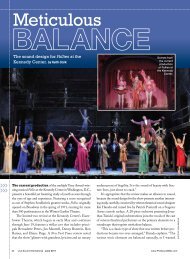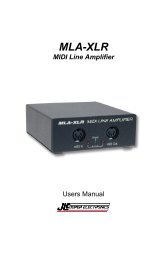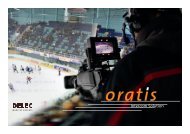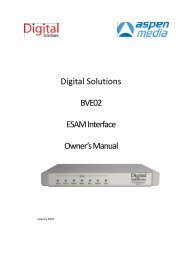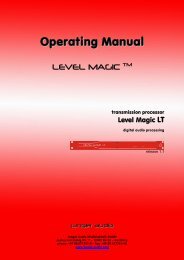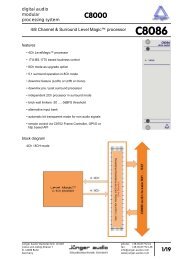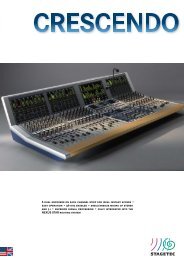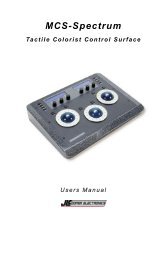Grace Design Catalogue - PDF - Aspen Media.
Grace Design Catalogue - PDF - Aspen Media.
Grace Design Catalogue - PDF - Aspen Media.
Create successful ePaper yourself
Turn your PDF publications into a flip-book with our unique Google optimized e-Paper software.
superior temperature stability, and all<br />
critical signal path resistors are fabricated<br />
with copper end caps rather than<br />
steel, which helps to avoid any inductive<br />
reactance. Ferrite beads, common<br />
mode chokes, and highly stable polypropylene<br />
capacitors form an input<br />
filter to protect the input amplifiers<br />
from RF interference. Ferrite beads also<br />
protect the output amplifiers from any<br />
interference on the output wires.<br />
Digital<br />
Analog to Digital Converters -<br />
Our new A/D converters represent the<br />
state of the art in high performance<br />
conversion for the most demanding<br />
music recording applications. An A/D<br />
converter can be divided into three<br />
basic functional blocks; the analog<br />
input stage, the A/D converter, and<br />
the clock generation (or regeneration).<br />
With any high performance A/D converter<br />
design, all three of these areas<br />
require complete attention and must<br />
be perfectly realized to achieve true<br />
high fidelity audio performance.<br />
Analog Input Stage - Our<br />
converter’s analog input circuitry is<br />
designed to be simple and pure. This<br />
fully differential circuitry contains no<br />
electrolytic capacitors and utilizes precision<br />
0.5% tolerance thin film resistors,<br />
which guarantees no signal coloration<br />
from capacitor dielectric absorption<br />
and resistor thermal modulation. Careful<br />
attention to grounding and power<br />
supply layout guarantees no sonic aberrations<br />
caused from unwanted interference<br />
from digital circuitry. The analog<br />
input amplifiers are powered from<br />
their own dedicated voltage regulators<br />
and each analog power supply rail is<br />
double regulated to provide extreme<br />
isolation from power line related noise.<br />
Driving the input of modern deltasigma<br />
converters requires a low driving<br />
impedance and high current from the<br />
A/D input driver, and our experience<br />
from designing high performance microphone<br />
amplifiers with precision line<br />
drivers translates very well to this task.<br />
A/D Converter - The A/D converter<br />
itself is the Cirrus CS5381. This<br />
converter employs a fifth order deltasigma<br />
modulator and a low pass filter<br />
that exhibits very wide dynamic range<br />
and low latency. With a more gentle<br />
slope digital filter than other ADC chips,<br />
the CS5381 is the most musical of the<br />
high end converter ICs and is capable<br />
of 120dB dynamic range with distortion<br />
and noise artifacts at less than<br />
-110dB. Separate power supplies for<br />
the analog and digital portions of the<br />
A/D converter ensure that the precision<br />
delta sigma modulator will not be<br />
affected by other surrounding circuitry.<br />
As well, the differential inputs provide<br />
additional input noise rejection.<br />
Clocks - A perfectly executed analog<br />
stage and the best performing A/D<br />
converter is only as good as the sampling<br />
clock. Even the smallest amounts<br />
of clock jitter will readily degrade the<br />
performance of the converter by introducing<br />
non-harmonically related noise<br />
and distortion.<br />
When operating on the internal<br />
clock, the A/D converter sample clock<br />
is generated by a quartz oscillator<br />
which has very low jitter. However,<br />
many applications require that the A/D<br />
converter be synchronized to an external<br />
clock source, usually in the form of a<br />
word clock, which is where the greatest<br />
challenge arises.<br />
There is a common misconception<br />
that using the word clock input on any<br />
piece of digital audio equipment will<br />
result in better sonic performance. In<br />
reality, the vast majority of word clock<br />
PLL circuits will have more intrinsic<br />
jitter than the word clock signal itself<br />
and usually more intrinsic jitter than<br />
the PLL within the AES/SPDIF receiver<br />
chip. As well, these PLLs usually have<br />
no incoming jitter attenuation in the<br />
audio band.<br />
Our A/D converters employ<br />
s-Lock, a two stage PLL system to<br />
provide practically jitter-free recovered<br />
clocks with extremely high incoming<br />
jitter attenuation. The first stage is a<br />
wide lock range ultra low noise analog<br />
PLL, which can lock to incoming word<br />
clocks and Digidesign® Loop Sync<br />
signals with a +/-8% lock range. Rather<br />
than using standard CMOS based PLL<br />
chips for the first stage PLL, we use an<br />
extremely quiet, discrete VCO (voltage<br />
controlled oscillator). When using<br />
a quality external clock source, this<br />
PLL alone will provide a nearly crystal<br />
quality clock. The incoming jitter rejection<br />
of this PLL begins at 500Hz and<br />
increases at 12dB/octave with rising<br />
frequency. The wide lock range allows<br />
for the converter to operate in varispeed<br />
applications without a sacrifice<br />
in audio performance, provided that<br />
the external clock source is relatively<br />
low jitter.<br />
When the incoming sample rate is<br />
within +/-200 ppm of the selected sample<br />
rate, the secondary (our proprietary<br />
s-Lock) crystal based PLL will lock to<br />
the first stage PLL, providing the quietest<br />
possible recovered sample clock to<br />
the A/D converters. The s-Lock PLL is<br />
capable of extreme rejection of incoming<br />
jitter, which begins at less than<br />
0.1Hz and is better than 60dB at 1kHz.<br />
While it is very easy (and economical)<br />
to provide “jitter free” sample clocks<br />
by routing the audio data through<br />
an ASRC (asynchronous sample rate<br />
converter), we believe that the convenience<br />
of these circuits does not outweigh<br />
the potential sonic degradation<br />
caused by additional signal processing.<br />
The performance of the s-Lock PLL<br />
renders even the worst case interface<br />
jitter artifacts to a level well below the<br />
noise floor of the A/D converter.<br />
Digital to Analog Converters<br />
Like the A/D converter, a D/A system is<br />
made up of three basic blocks; analog<br />
output circuitry, the D/A converter, and<br />
the clock system. The analog stage and<br />
clock design has very similar requirements<br />
to the A/D converter design.<br />
However, the D/A analog interface has<br />
some special requirements. All of our<br />
products that contain reference quality<br />
D/A converters use Burr Brown DACs<br />
with current outputs. This important<br />
feature allows us to construct an ultracritical<br />
current to voltage converter<br />
using transimpedance amplifiers. The<br />
use of transimpedance amplifiers assures<br />
that reconstruction of the analog<br />
signal is done without the non-linear<br />
slew rate limiting of regular op amps.<br />
While the benefits of this type of<br />
topology are not readily apparent in<br />
measured performance it makes a significant<br />
improvement in the clarity and<br />
resolving power of the DAC.<br />
Our D/A converter products all employ<br />
a two stage PLL system with the<br />
same s-Lock crystal based oscillator as<br />
in the A/D converters.<br />
Summary - Creating audio circuitry<br />
which performs to a high level of<br />
measured performance is the starting<br />
point of our designs. Measurable performance<br />
parameters such as distortion,<br />
noise, phase and bandwidth are<br />
important, but music does not behave<br />
like a steady state sine wave test tone - it<br />
is an infinitely complex waveform. Our<br />
designs are always optimized for music<br />
and all design decisions are verified by<br />
ear, the most sensitive test instrument<br />
available.<br />
We regard electronic design as a<br />
holistic process which should result<br />
in products of uncompromised sonic<br />
performance, complete reliability, and<br />
beauty. If all electrical and mechanical<br />
details are considered at every stage of<br />
development, the result will stand the<br />
test of time.<br />
TECHNICAL DISCUSSION<br />
THE




